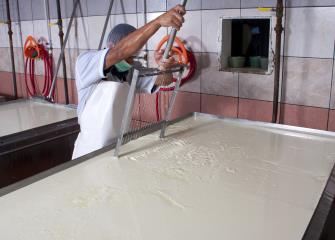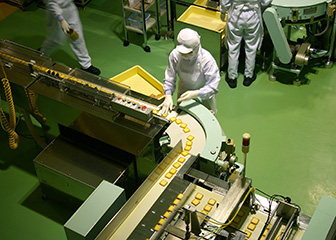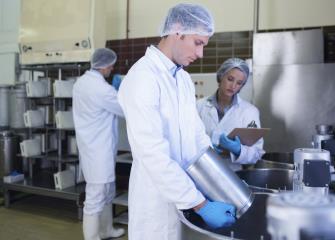Food Processing Workers, All Other
Does this career fit your work personality?
Begin The Career Assessment Test- Best Fitting Careers
- Work Personality Strengths
- Work Style Preferences
- and more
Job Outlook
Overall employment of food processing equipment workers is projected to grow 6 percent from 2022 to 2032, faster than the average for all occupations.
About 39,900 openings for food processing equipment workers are projected each year, on average, over the decade. Many of those openings are expected to result from the need to replace workers who transfer to different occupations or exit the labor force, such as to retire.
Summary of What they do:
All food processing workers not listed separately.
What Food Processing Equipment Workers Do
Food processing equipment workers operate machinery that mixes, cooks, or processes ingredients for manufacturing food products.
Duties

Food processing equipment workers typically do the following:
- Set up, start, or load food processing equipment
- Check, weigh, and mix ingredients according to recipes
- Set and control temperatures, flow rates, and pressures of machinery
- Monitor and adjust ingredient mixes during production processes
- Observe and regulate equipment gauges and controls
- Record batch production data
- Clean workspaces and equipment according to health and safety standards
- Check final products to ensure quality
Food processing equipment workers often have different duties depending on the type of machinery they use or the goods they process. Job titles may be specific to the type of food workers produce.
Food and tobacco roasting, baking, and drying machine operators and tenders run equipment that uses dry heat to make food or tobacco products. For example, coffee roasters follow recipes and tend machines to produce standard or specialty coffees; dryers of fruits and vegetables operate machines that produce raisins, prunes, and other dehydrated foods.
Food batchmakers operate equipment that mixes or blends ingredients to produce shelf-stable, refrigerated, or frozen foods. For example, cheese makers load raw ingredients into machinery, monitoring the temperature and consistency throughout the production process; candy makers may operate machinery to shape, stretch, or mold lollipops, gumdrops, and other sweets.
Food cooking machine operators and tenders oversee equipment that makes steamed, fried, boiled, or related food products. For example, dumpling machine operators set up and monitor commercial steamers and potato chip manufacturing workers may operate frying equipment.
Other food processing equipment workers operate machines that mix spices, mill grains, or extract oil from seeds.
Important Qualities
Detail oriented. Workers must be able to detect small changes in the quality or quantity of food products. They must also follow health and safety standards to avoid injury and prevent food contamination.
Physical stamina. Workers stand for long periods as they tend machines and monitor the production process.
Physical strength. Food processing equipment workers must be able to lift or move heavy boxes of ingredients, which may weigh up to 50 pounds.
Math skills. Workers may need math skills in order to accurately mix specific quantities of ingredients.
Work Environment

Food and tobacco processing workers held about 269,200 jobs in 2022. Employment in the detailed occupations that make up food and tobacco processing workers was distributed as follows:
| Food batchmakers | 171,500 |
| Food processing workers, all other | 48,800 |
| Food cooking machine operators and tenders | 27,300 |
| Food and tobacco roasting, baking, and drying machine operators and tenders | 21,500 |
The largest employers of food and tobacco processing workers were as follows:
| Food manufacturing | 76% |
| Employment services | 6 |
Food manufacturing facilities are typically large, open-floor areas with loud machinery. When operating cooking equipment, workers are frequently exposed to high temperatures. When working with goods that need to be refrigerated or frozen, they may be exposed to cold temperatures for long periods.
Depending on the type of food being processed, workers may be required to wear ear protection to guard against hearing loss in noisy facilities. They also may wear masks, hairnets, or gloves to prevent product contamination.
Workers usually stand during their shifts while tending machines or observing the production process. Loading, unloading, or cleaning equipment may require lifting, bending, and reaching.
Injuries and Illnesses
Food processing workers, all other, have one of the highest rates of injuries and illnesses of all occupations. ("All other" titles represent occupations with a wide range of characteristics that do not fit into any of the other detailed occupations.) Working around hot liquids or machinery that cuts or presses can be dangerous. Common injuries include cuts or result from slips and falls.. To reduce the risks of injuries, workers are required to wear protective clothing and nonslip shoes.
Work Schedules
Most food processing equipment workers are employed full time; part-time work may be common for food cooking machine operators and tenders. Because of production schedules, shift work is common and may include early mornings, evenings, or nights.
Some food processing positions are seasonal.
Getting Started
How to Become a Food Processing Equipment Worker

Education requirements vary for food processing equipment workers. Some typically need no formal education credential; however, others typically need a high school diploma or equivalent. Food processing equipment workers usually learn their skills through on-the-job training.
Education
Employers may require or prefer that applicants to food processing equipment jobs have a high school diploma or equivalent.
Because these workers often adjust the quantity of ingredients that go into a mix, math and reading skills are helpful.
Training
Food processing equipment workers learn on the job. Training may last from a few weeks to a few months. During training, workers learn health and safety rules related to the type of food that they process, as well as how to operate specific equipment and detect malfunctions.
Experienced workers typically teach trainees how to properly use and care for equipment.
Contacts for More Information
For more information about food processing equipment workers, visit
Bakery, Confectionary, Tobacco Workers, and Grain Millers International (BCTGM)
Similar Occupations
This table shows a list of occupations with job duties that are similar to those of food processing equipment workers.
| Occupation | Job Duties | Entry-Level Education | Median Annual Pay, May 2022 | |
|---|---|---|---|---|

|
Agricultural and Food Science Technicians |
Agricultural and food science technicians assist agricultural and food scientists. |
Associate's degree | $46,140 |

|
Bakers |
Bakers mix ingredients according to recipes in order to make breads, pastries, and other baked goods. |
No formal educational credential | $32,780 |

|
Butchers |
Butchers cut, trim, and package meat for retail sale. |
No formal educational credential | $36,930 |

|
Cooks |
Cooks season and prepare foods, including soups, salads, entrees, and desserts. |
See How to Become One | $30,910 |

|
Food Preparation Workers |
Food preparation workers perform a variety of tasks other than cooking, such as slicing meat and brewing coffee. |
No formal educational credential | $29,790 |

|
Metal and Plastic Machine Workers |
Metal and plastic machine workers set up and operate equipment that cuts, shapes, and forms metal and plastic materials or pieces. |
See How to Become One | $41,060 |
